What is Smishing Attack and How to Prevent it?
What is Smishing?
Smishing is a cybercrime that uses manipulative text messages to steal confidential personal and business information from people. Cybercriminals send carefully crafted text messages to the victim, urging them to respond or take further action. smishing attack The text message can ask the victim to confirm delivery of an Amazon order or ask the recipient to click a link to complete registration for a new government program.
The ultimate goal of any smishing tactic is the same: to compromise people by stealing confidential information.
 Click here to download Free RAM Free Antivirus
Click here to download Free RAM Free Antivirus
What Are The Different Smishing Tactics?
- Fake Link Tactic
The sender of the text message claims to represent a valid organization or business and includes a link that closely resembles the actual URL of the organization or business. The sender asks the recipient to click on the link and take action such as updating their personal information, confirming the delivery of a package, or entering a raffle for a free prize.
- Convincing phone call
The text message asks the victim to call back the sender. Often times, the text message appears to come from a government or municipal organization and uses urgent language to convince the victim that they must call immediately to protect themselves from serious consequences. When the victim calls the number, they are talking to someone who seems legitimate, who is very helpful and reassuring – the victim believes they are doing the right thing by providing the information the person needs.
- Malware attack
The text message includes a link to an executable that installs malware on the victim’s mobile device. Typically, the cybercriminal installs the Trojan Horse software which captures and logs the victim’s keystrokes, making it easier to steal passwords, contact lists, banking information, etc.
- Spear Smishing
This type of smishing requires more work and research on the part of the cybercriminal. Using basic victim information collected from social media sites such as Facebook and LinkedIn, the cybercriminal can send a targeted and specific smishing attack that appears legitimate. Due to the personal nature of the smishing message, the victim trusts the sender and does not hesitate to respond.
Why Are Smishing Attacks Performed?
Cybercriminals today are primarily motivated by financial gain. They develop code designed to hide your sensitive information for profit. When they get this data, they may be looking to sell your compromised credit card or credentials on the dark web. They may also use sensitive data to open an account in your name or hold your data ransom in exchange for a large payment.
Motivated cybercriminals use smishing due to the huge volume of mobile devices connected to the internet today. The attack surface is so large that an attacker can skillfully craft a text message and deliver it to thousands of addresses in seconds.
How Smishing Works
Smishing uses social engineering techniques to trick text message recipients into revealing personal or financial information. For example, during the holidays, you receive an SMS claiming to be from a well-known retailer asking you to go check your billing information or your package will not be dispatched in time to make it the gift recipient. The only problem is that the fake text message provides you with a fake link to a website, where the information you provide will be used to commit identity theft, fraud, and other crimes. Smishing is also used to spread malware and spyware through links or attachments that can steal information and perform other malicious tasks. The messages usually contain some sort of urgency, threat, or warning to try to get the recipient to take immediate action.
How to Protect from Smishing Attacks
Like email phishing, Protection against smishing depends on the ability of the targeted user to identify a smishing attack and ignore or report the message. If a phone number is often used in scams, the Telecom may warn users who receive messages from a known scam number or drop the message altogether.
- Smishing messages are only dangerous if the targeted user acts on them by clicking on the link or sending private data to the attacker.
- Here are some ways to detect smishing and avoid becoming a victim:
- The message offers quick cash by winning prizes or collecting money after entering information. Promotional code offers are also popular.
- Financial institutions will never send a text requesting credentials or a money transfer. Never send credit card numbers, ATM PINs, or banking information to anyone in text messages.
- Avoid answering a phone number you don’t recognize.
- Messages received from a number with only a few digits were probably from an email address, which is a sign of spam.
- The banking information stored on the smartphone is a target for attackers. Avoid storing this information on a mobile device. If an attacker installs malicious software on the smartphone, this banking information could be compromised.
- Telecoms offer numbers to report attacks. To protect other users, send the message to your telecom number so that it can be investigated. The FCC also accepts complaints and investigates SMS scams.
This article covers the answers to some of your frequently asked questions:
People May Also Like…
Operating System (OS) security
Securing Operating System: Protecting Digital Environments In the rapidly changing world of technology, operating system (OS) security is a vital line of defence against online attacks. Operating system security is the first line of defence
Data protection
What is the data protection Data protection has grown to be of utmost importance to both individuals and organizations in the connected. world of today, where information travels quickly across many digital
What is a security software
Security software It is impossible to overstate the value of strong security software in today's digital world. Individuals and organizations must take proactive measures to safeguard their sensitive data and defend against
Website reputation analysis
Website reputation analysis Websites are incredibly important for establishing an online presence for businesses, organizations, and people in the modern world. Analysis and evaluation of a website's reputation are crucial because there are








